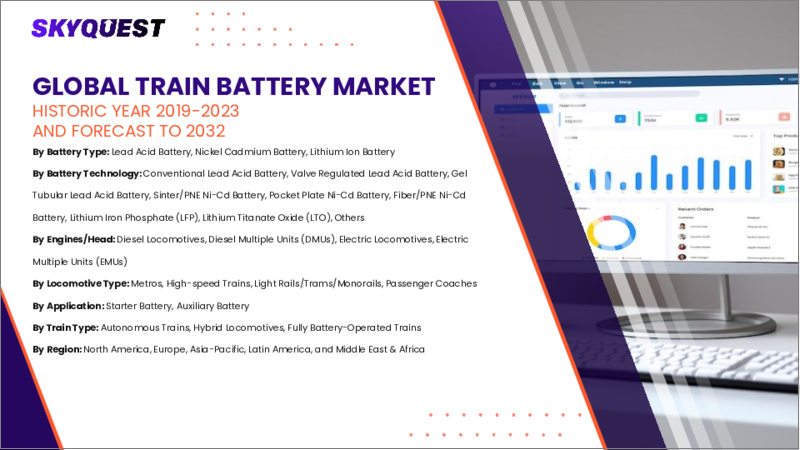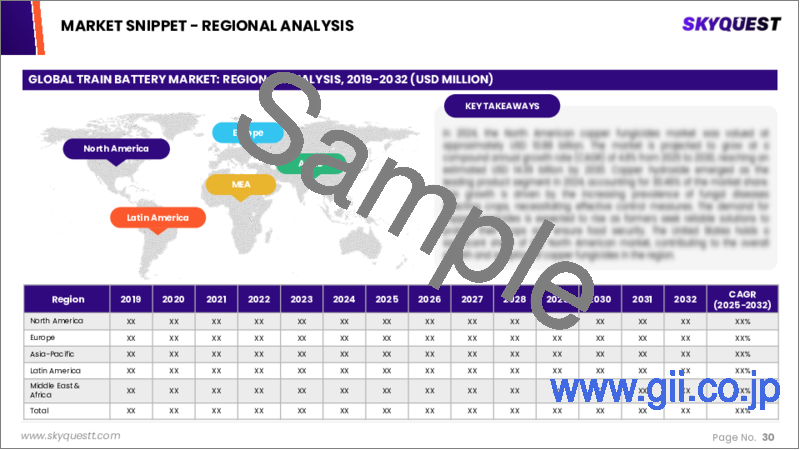|
|
市場調査レポート
商品コード
1596919
列車用バッテリーの市場規模、シェア、成長分析、バッテリータイプ別、車両タイプ別、列車タイプ別、地域別 - 産業予測、2024年~2031年Train Battery Market Size, Share, Growth Analysis, By Battery Type (Lead Acid, Nickel Cadmium), By Rolling Stock Type (Locomotive, Metro), By Train Type (Hybrid, Battery Operated), By Region - Industry Forecast 2024-2031. |
||||||
|
|||||||
| 列車用バッテリーの市場規模、シェア、成長分析、バッテリータイプ別、車両タイプ別、列車タイプ別、地域別 - 産業予測、2024年~2031年 |
|
出版日: 2024年11月21日
発行: SkyQuest
ページ情報: 英文 200 Pages
納期: 3~5営業日
|
全表示
- 概要
- 目次
世界の列車用バッテリーの市場規模は、2022年に5億米ドルとなり、2023年の5億2,000万米ドルから、2031年までには7億6,000万米ドルに成長し、予測期間(2024年~2031年)のCAGRは4.7%で成長する見通しです。
列車用バッテリー市場は、鉄道電化への世界の投資と高速鉄道の需要増加により、大きな成長が見込まれています。鉄道の電化が進むにつれ、照明や推進システムなどさまざまな用途をサポートする信頼性の高いバッテリーのニーズが高まっています。列車推進用の電気モーターへの継続的な移行は、列車用電池の採用をさらに促進し、市場拡大のための有利な状況を作り出すと予想されます。鉄道の電化を支援することを目的とした政府の取り組みと資金は、列車用バッテリー分野の発展を後押しする上で重要な役割を果たすと予想されます。しかし、現在のバッテリー技術ではエネルギー密度や航続距離に限界があるなどの課題があり、短期的には販売が阻害される可能性があります。とはいえ、バッテリー技術の進歩は、列車用バッテリー市場の企業にとって有望な機会となっています。バッテリーの性能を革新し改善することで、メーカーは新たな収益源を開拓し、鉄道業界の進化するニーズに応えることができ、最終的にはより持続可能で効率的な輸送フレームワークに貢献することができます。全体として、列車用バッテリー市場の見通しは、既存の課題にもかかわらず、投資の増加、技術の進歩、政府の支援政策に後押しされ、引き続き明るいです。
目次
イントロダクション
- 調査の目的
- 調査範囲
- 定義
調査手法
- 情報調達
- 二次データと一次データの方法
- 市場規模推定
- 市場の前提条件と制限
エグゼクティブサマリー
- 世界市場の見通し
- 供給と需要のトレンド分析
- セグメント別機会分析
市場力学と見通し
- 市場概要
- 市場規模
- 市場力学
- 促進要因と機会
- 抑制要因と課題
- ポーター分析と影響
- 競争企業間の敵対関係
- 代替品の脅威
- 買い手の交渉力
- 新規参入業者の脅威
- 供給企業の交渉力
主要な市場の考察
- 主要な成功要因
- 競合の程度
- 主要な投資機会
- 市場エコシステム
- 技術の進歩
- 規制情勢
- バリューチェーン分析
- ケーススタディ分析
- PESTEL分析
- 市場の魅力指数
- サプライチェーン分析
世界の列車用バッテリーの市場規模:タイプ別・CAGR(2024年~2031年)
- 鉛蓄電池
- ニッケルカドミウム電池
- リチウムイオン電池
世界の列車用バッテリーの市場規模:技術別・CAGR別(2024年~2031年)
- 従来の鉛蓄電池
- 制御弁式鉛蓄電池
- ゲル管状鉛蓄電池
- シンター/PNEニッケル水素電池
- ポケットプレートNi-Cdバッテリー
- ファイバー/PNEニッケル水素電池
- リン酸鉄リチウム(LFP)
- チタン酸リチウム(LTO)
- その他
世界の列車用バッテリーの市場規模:エンジン別・CAGR(2024年~2031年)
- ディーゼル機関車
- ディーゼル機関車(DMU)
- 電気機関車
- 電車(EMU)
世界の列車用バッテリーの市場規模:用途別・CAGR(2024年~2031年)
- メトロ
- 高速鉄道
- ライトレール / 路面電車 / モノレール
- 旅客バス
世界の列車用バッテリーの市場規模:地域別・CAGR(2024年~2031年)
- 北米(タイプ別、技術別、エンジン別、用途別)
- 米国
- カナダ
- 欧州(タイプ別、技術別、エンジン別、用途別)
- 英国
- ドイツ
- スペイン
- フランス
- イタリア
- その他欧州地域
- アジア太平洋(タイプ別、技術別、エンジン別、用途別)
- 中国
- インド
- 日本
- 韓国
- その他アジア太平洋
- ラテンアメリカ(タイプ別、技術別、エンジン別、用途別)
- ブラジル
- その他ラテンアメリカ地域
- 中東・アフリカ(タイプ別、技術別、エンジン別、用途別)
- GCC諸国
- 南アフリカ
- その他中東・アフリカ
競合情報
- 上位5社の比較
- 主要企業の市場ポジショニング(2023年)
- 主要な市場企業が採用した戦略
- 市場の最近の動向
- 企業の市場シェア分析(2023年)
- 主要企業の企業プロファイル
- 会社概要
- 製品ポートフォリオ分析
- 企業のセグメント別シェア分析
- 収益の前年比比較(2021年~2023年)
主要企業プロファイル
- AEG Power Solutions
- ENERSYS
- HBL Power Systems Limited
- Saft(TotalEnergies)
- East Penn Manufacturing Company
- Amara Raja Batteries Limited
- Shuangdeng Group Co, Ltd.
- Leclanche
- BorgWarner Akasol AG
- Ecobat
- Power & Industrial Battery Systems GmbH
- Hoppecke Batteries Inc.
- Exide Industries Ltd.
- GS Yuasa Corporation
- Hitachi Rail Limited
- Shield Batteries Limited
- Fengri Power & Electric Co. Limited
- SEC Battery
- First National Battery
- Toshiba Corporation
結論と提言
Global Train Battery Market size was valued at USD 500 Million in 2022 and is poised to grow from USD 520 Million in 2023 to USD 760 Million by 2031, growing at a CAGR of 4.7% in the forecast period (2024-2031).
The train battery market is poised for significant growth, driven by global investments in railway electrification and increasing demand for high-speed trains. As railways transition towards electrification, there is a rising need for reliable batteries to support various applications, including lighting and propulsion systems. The continued shift to electric motors for train propulsion is expected to further enhance the adoption of train batteries, creating a favorable landscape for market expansion. Government initiatives and funding aimed at supporting railway electrification are anticipated to play a crucial role in boosting the development of the train battery sector. However, challenges such as limited energy density and range of current battery technologies may impede sales in the short term. Nevertheless, ongoing advancements in battery technology present promising opportunities for companies within the train battery market. By innovating and improving battery performance, manufacturers can tap into new revenue streams and meet the evolving needs of the rail industry, ultimately contributing to a more sustainable and efficient transportation framework. Overall, the outlook for the train battery market remains positive, fueled by rising investments, technological advancements, and supportive government policies, despite the existing challenges.
Top-down and bottom-up approaches were used to estimate and validate the size of the Global Train Battery market and to estimate the size of various other dependent submarkets. The research methodology used to estimate the market size includes the following details: The key players in the market were identified through secondary research, and their market shares in the respective regions were determined through primary and secondary research. This entire procedure includes the study of the annual and financial reports of the top market players and extensive interviews for key insights from industry leaders such as CEOs, VPs, directors, and marketing executives. All percentage shares split, and breakdowns were determined using secondary sources and verified through Primary sources. All possible parameters that affect the markets covered in this research study have been accounted for, viewed in extensive detail, verified through primary research, and analyzed to get the final quantitative and qualitative data.
Global Train Battery Market Segmental Analysis
Global Train Battery Market is segmented by Type, by Technology, by Engines, by Application, and by Region. Based on Type, the market is segmented into Lead Acid Battery, Nickel Cadmium Battery, Lithium Ion Battery. Based on Technology, the market is segmented into Conventional Lead Acid Battery, Valve Regulated Lead Acid Battery, Gel Tubular Lead Acid Battery, Sinter/PNE Ni-Cd Battery, Pocket Plate Ni-Cd Battery, Fiber/PNE Ni-Cd Battery, Lithium Iron Phosphate (LFP), Lithium Titanate Oxide (LTO), Others Based on Engines, the market is segmented into Diesel Locomotives, Diesel Multiple Units (DMUs), Electric Locomotives, Electric Multiple Units (EMUs). Based on Application, the market is segmented into Metros, High-speed Trains, Light Rails/Trams/Monorails, Passenger Coaches, Starter Battery, and Auxiliary battery. Based on region, the market is segmented into North America, Europe, Asia Pacific, Latin America and Middle East & and Africa.
Driver of the Global Train Battery Market
A significant driver of the Global Train Battery market is the electrification of rail transportation. Recent advancements in battery technology, coupled with the rising popularity of hybrid trains, have facilitated this transition. Furthermore, the surge in investments aimed at developing rail transport infrastructure and enhancing electrification efforts is expected to play a crucial role in increasing the demand for train batteries in the future. As stakeholders prioritize environmental sustainability and efficiency, the momentum towards electrifying rail networks will likely result in a robust growth trajectory for the train battery sector, positioning it as a vital component of modern rail systems.
Restraints in the Global Train Battery Market
One of the significant restraints impacting the global train battery market is the high initial investment required for deployment. Railway companies face considerable costs when integrating batteries into their trains, which can be daunting for organizations operating on tight budgets. This financial burden may deter some companies from making the necessary technological advancements, leading to a slower-paced development in the adoption and implementation of train battery solutions. Consequently, the market may experience delays in growth as potential participants weigh the substantial upfront expenses against their financial capabilities, ultimately hindering overall progress within the sector.
Market Trends of the Global Train Battery Market
The global train battery market is experiencing a notable trend towards advancements in battery technology, driven by the increasing demand for sustainable and efficient transportation solutions. As railway operators seek to reduce carbon emissions and improve operational efficiency, battery providers are prioritizing investments in research and development to enhance energy density and reduce charging times. This focus on innovation is expected to bolster the long-term sales potential of advanced train batteries, positioning them as a pivotal component in the modernization of rail systems. As a result, companies that successfully implement these advancements are likely to gain a competitive edge in the evolving global market.
Table of Contents
Introduction
- Objectives of the Study
- Scope of the Report
- Definitions
Research Methodology
- Information Procurement
- Secondary & Primary Data Methods
- Market Size Estimation
- Market Assumptions & Limitations
Executive Summary
- Global Market Outlook
- Supply & Demand Trend Analysis
- Segmental Opportunity Analysis
Market Dynamics & Outlook
- Market Overview
- Market Size
- Market Dynamics
- Driver & Opportunities
- Restraints & Challenges
- Porters Analysis & Impact
- Competitive rivalry
- Threat of substitute
- Bargaining power of buyers
- Threat of new entrants
- Bargaining power of suppliers
Key Market Insights
- Key Success Factors
- Degree of Competition
- Top Investment Pockets
- Market Ecosystem
- Technological Advancement
- Regulatory Landscape
- Value Chain Analysis
- Case Study Analysis
- PESTEL Analysis
- Market Attractiveness Index
- Supply Chain Analysis
Global Train Battery Market Size by Type & CAGR (2024-2031)
- Lead Acid Battery
- Nickel Cadmium Battery
- Lithium Ion Battery
Global Train Battery Market Size by Technology & CAGR (2024-2031)
- Conventional Lead Acid Battery
- Valve Regulated Lead Acid Battery
- Gel Tubular Lead Acid Battery
- Sinter/PNE Ni-Cd Battery
- Pocket Plate Ni-Cd Battery
- Fiber/PNE Ni-Cd Battery
- Lithium Iron Phosphate (LFP)
- Lithium Titanate Oxide (LTO)
- Others
Global Train Battery Market Size by Engines & CAGR (2024-2031)
- Diesel Locomotives
- Diesel Multiple Units (DMUs)
- Electric Locomotives
- Electric Multiple Units (EMUs)
Global Train Battery Market Size by Application & CAGR (2024-2031)
- Metros
- High-speed Trains
- Light Rails/Trams/Monorails
- Passenger Coaches
Global Train Battery Market Size by Region & CAGR (2024-2031)
- North America, (by Type, by Technology, by Engines, by Application)
- US
- Canada
- Europe, (by Type, by Technology, by Engines, by Application)
- UK
- Germany
- Spain
- France
- Italy
- Rest of Europe
- Asia-Pacific, (by Type, by Technology, by Engines, by Application)
- China
- India
- Japan
- South Korea
- Rest of Asia Pacific
- Latin America, (by Type, by Technology, by Engines, by Application)
- Brazil
- Rest of Latin America
- Middle East & Africa, (by Type, by Technology, by Engines, by Application)
- GCC Countries
- South Africa
- Rest of Middle East & Africa
Competitive Intelligence
- Top 5 Player Comparison
- Market Positioning of Key Players, 2023
- Strategies Adopted by Key Market Players
- Recent Developments in the Market
- Company Market Share Analysis, 2023
- Company Profiles of All Key Players
- Company Details
- Product Portfolio Analysis
- Company's Segmental Share Analysis
- Revenue Y-O-Y Comparison (2021-2023)
Key Company Profiles
- AEG Power Solutions
- Company Overview
- Business Segment Overview
- Financial Updates
- Key Developments
- ENERSYS
- Company Overview
- Business Segment Overview
- Financial Updates
- Key Developments
- HBL Power Systems Limited
- Company Overview
- Business Segment Overview
- Financial Updates
- Key Developments
- Saft (TotalEnergies)
- Company Overview
- Business Segment Overview
- Financial Updates
- Key Developments
- East Penn Manufacturing Company
- Company Overview
- Business Segment Overview
- Financial Updates
- Key Developments
- Amara Raja Batteries Limited
- Company Overview
- Business Segment Overview
- Financial Updates
- Key Developments
- Shuangdeng Group Co, Ltd.
- Company Overview
- Business Segment Overview
- Financial Updates
- Key Developments
- Leclanche
- Company Overview
- Business Segment Overview
- Financial Updates
- Key Developments
- BorgWarner Akasol AG
- Company Overview
- Business Segment Overview
- Financial Updates
- Key Developments
- Ecobat
- Company Overview
- Business Segment Overview
- Financial Updates
- Key Developments
- Power & Industrial Battery Systems GmbH
- Company Overview
- Business Segment Overview
- Financial Updates
- Key Developments
- Hoppecke Batteries Inc.
- Company Overview
- Business Segment Overview
- Financial Updates
- Key Developments
- Exide Industries Ltd.
- Company Overview
- Business Segment Overview
- Financial Updates
- Key Developments
- GS Yuasa Corporation
- Company Overview
- Business Segment Overview
- Financial Updates
- Key Developments
- Hitachi Rail Limited
- Company Overview
- Business Segment Overview
- Financial Updates
- Key Developments
- Shield Batteries Limited
- Company Overview
- Business Segment Overview
- Financial Updates
- Key Developments
- Fengri Power & Electric Co. Limited
- Company Overview
- Business Segment Overview
- Financial Updates
- Key Developments
- SEC Battery
- Company Overview
- Business Segment Overview
- Financial Updates
- Key Developments
- First National Battery
- Company Overview
- Business Segment Overview
- Financial Updates
- Key Developments
- Toshiba Corporation
- Company Overview
- Business Segment Overview
- Financial Updates
- Key Developments





